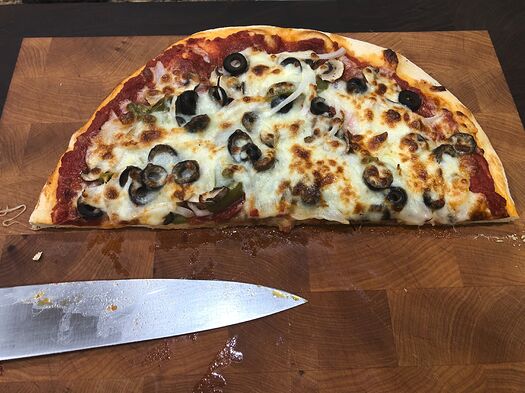Or maybe give me an excuse to buy some 10" pans…
Excuses, shmexcuses. None needed. Just DO EEEET.
the best pans for this style can be purchased and shipped from bay state restaurant products in brockton ma. This is where the local restaurants are purchasing their pans. We have three and their fantastic.
wonderful job! I’m friends with a guy who owns a couple of pizza restaurants in boston, he’s very well known in the industry. He’s been to all the south shore spots, has talked to some of the owners, some of the chefs, etc. and helped us figure out the recipe and process.
After people spent months figuring it all this out, this got posted and turns out it’s spot on. no butter in the dough but note the cheddar cheese to mozz ratio and the sauce recipe.
A great feature of these stacking pans is their internal resting ring that leaves room to proof dough while they’re stacked.
Quite an interesting design for the trade!
^^^ This! ![]()
decided to edit.
as you might imagine, there’s a lot of stacking in pizza restaurants. Dough trays are stacked, individual dough containers are stackable, etc.
Notes: The batch of dough I made (using sourdough discard) was really enough for four pizzas, so next time I’ll save half. Crusts were good but too thick.
This guy is a little too dark! And has fresh cherry tomatoes from the garden. I bit into one and the superheated liquid inside burnt my lip pretty good. Pizza risk.
Lovely pizza!
Thank you! I’m super happy with the dough, still working on the cooking method. If bake at 450 with sauce, then add cheese and broil (as I did last night), the crust cooks through, but it also gets a little hard. If I broil with everything, the crust is great at the edges but a little soggy in the center. Dilemma.
can you bake at 500 or 550?
I can - you think a shorter/hotter bake + broil is the answer?
Yes, it should help. Adjusting the hydration level of your dough could help too - what hydration are you using now?
It’s hard for me to figure out 'cause some of the dough is sourdough discard. But if you want to take a shot:
227g sourdough discard
141g water
300g AP flour
60%? It was a pretty wet dough and impossible to shape without flouring it some more.
You only want to change one thing at a time, most of us cook 515 to 550f, try to move it to 500 next bake and see what happens. Are you using a stone?
A steel.
I don’t do ‘personal pan’ size pizzas, so that’s strike one…
but for a really mean crust - I use a baking stone. ‘steels’ is another option…
I one hour preheat the oven&stone to 550’F - not all ovens will do 550’F - use the max.
I ‘make’ the pizza - formed crust, tomato sauce ladled in, all topping added.
I do thinnest to thickest toppings: pepperoni/sliced onion/ sliced green pepper/mushrooms/half-sliced black olives. the cheese goes on last - it ‘glues’ all the toppings together.
the pizza goes on the pre-heated stone, and in 2-3 minutes I reduce the oven temp to 425’F. the heat from the super-hot stone does the crust, the lower temp then cooks the pizza thru.
if you want the cheese to brown, use 450’F - and be prepared to lower the temp & spill the heat out of the oven if it gets too browned.
it’s a “method” - adapt the details to your experience.
ps: my hydration is much higher…
If your sourdough discard was 100% (equal parts flour and water by volume ETA that should say weight, doh!), then your finished dough would have been around 61-62%, but a 61% dough would not be wet to the touch, at least once gluten was properly developed. Typically you’d need to be approaching 75% hydration to perceive a dough as wet enough to need extra flour to be handled. The large quantity of starter relative to the total amount of dough may be negatively affecting gluten development, which could also be contributing to the texture issues with the crust. The lack of irregular bubbles in your cornicione would indicate that as well. Was the crust relatively dense inside?
No, it was actually pretty light, although the bubbles were not irregular (you can see there’s no “blistering”). And the texture was fine - did I say somewhere that it was not? Ah, I said it was hard. I meant the outer crust, not the dough all the way through.
Equal parts flour & water by weight, not volume. And although it rose very nicely (after a night in the fridge), it was super sticky and sought its own level. I should take a picture of my soup dough next time.




